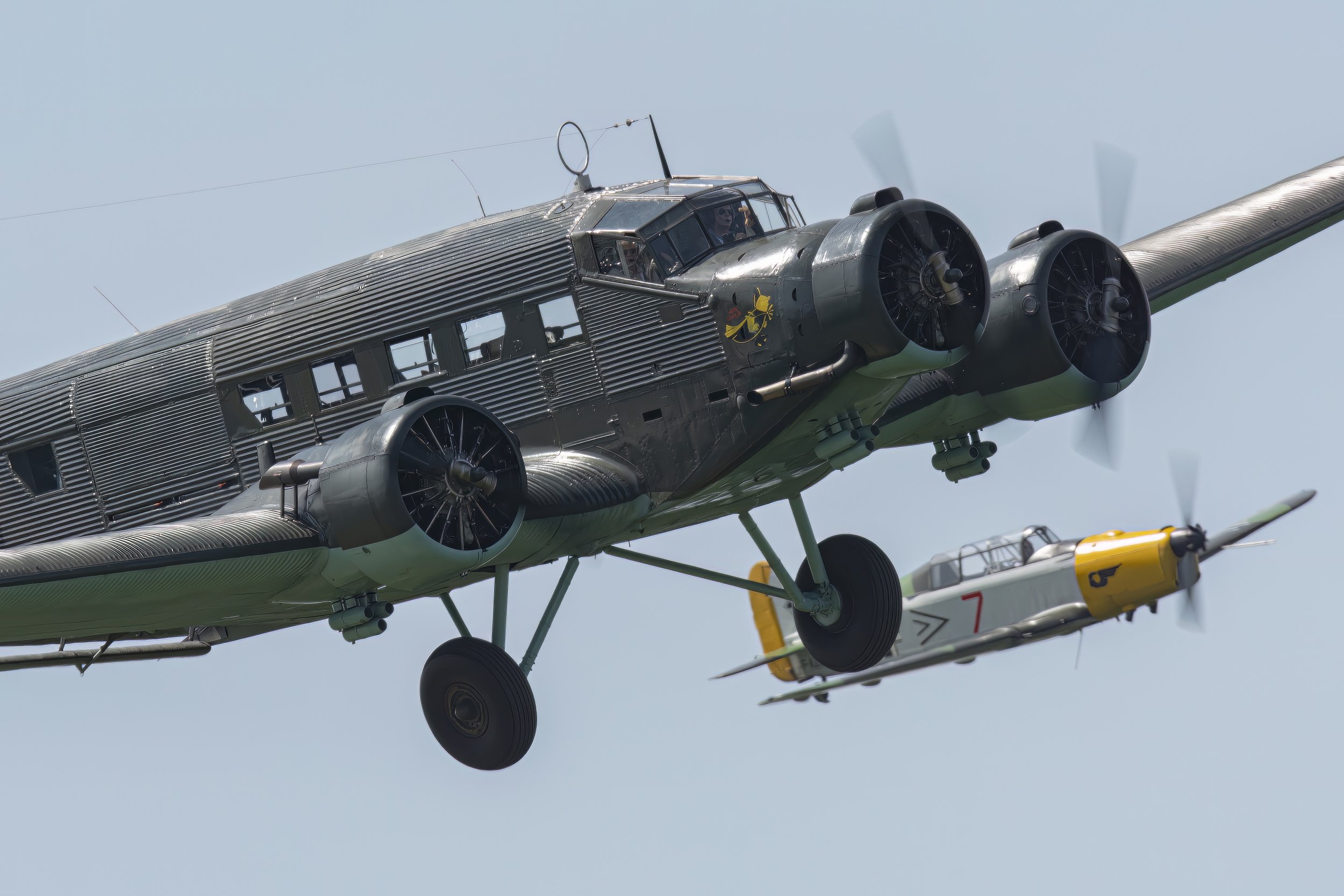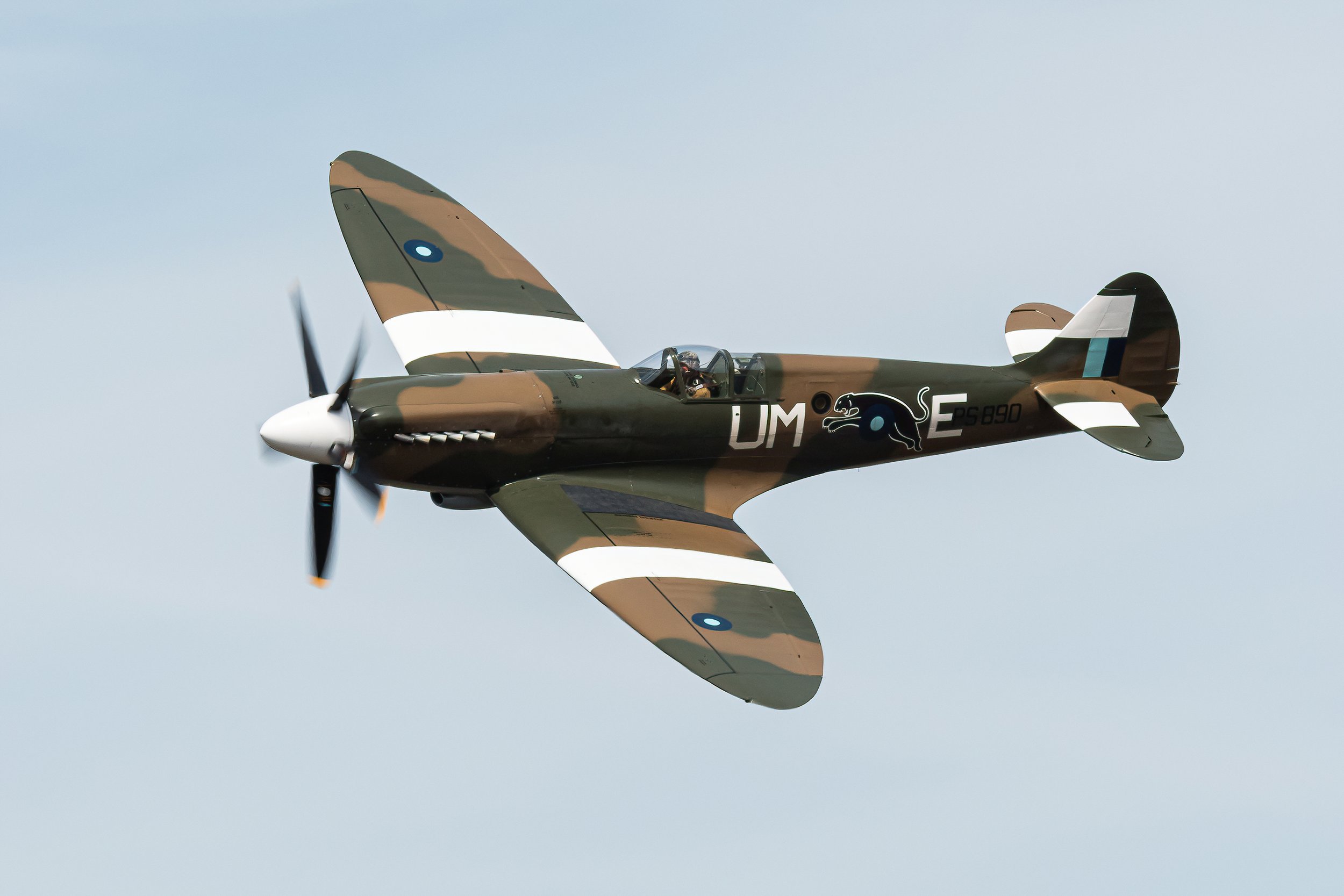Skyrider F-AZFN
Year built
1951
Aircraft
Douglas AD-4N Skyraider
Base
Jean-Baptiste Salis Airfield
This Skyraider is an AD 4-NA that is thought to have fought in Korea with the VC-35 between 1952 and 1953, before coming into service with the French Armée de l’Air, which received 133 Skyraiders out of the US Navy stock.
Stored on the Châteaudun air base until the end of 1975, it was delivered to the Chad Republic with five other Skyraiders, by ex-French Air Force pilots, to fight the Libyans who had infiltrated Chad.
Abandoned at the N’Djamena airport, it was rescued and it was flown back by the members of the association AMPAA in 1988.
After many stops in Niger, Algeria and Morocco, BuAer 125716 flew all the way to its new base at Melun-Villaroche.
Registered F-AZFN in August 1989, it was painted back to the colours of the EAA1/22 that it was wearing in 1974.
It was then displayed at many airshows by the AMPAA and changed hands to integrate the fleet of France’s Flying Warbirds in September 2013.
| Back to Top |
Douglas AD-4N Skyraider
The Douglas A-1 Skyraider (formerly known as AD Skyraider) is an American single-seat attack aircraft that saw service between the late 1940s and early 1980s. The Skyraider had a remarkably long and successful career; it became a piston-powered, propeller-driven anachronism in the jet age, and was nicknamed "Spad", after the French World War I fighter.
It was operated by the United States Navy (USN), the United States Marine Corps (USMC), and the United States Air Force (USAF), and also saw service with the British Royal Navy, the French Air Force, the Republic of Vietnam Air Force (RVNAF), and others. It remained in U.S. service until the early 1970s.
The piston-engined Skyraider was designed during World War II to meet United States Navy requirements for a carrier-based, single-seat, long-range, high-performance dive/torpedo bomber, to follow on from earlier types such as the Curtiss SB2C Helldiver and Grumman TBF Avenger. Designed by Ed Heinemann of the Douglas Aircraft Company, prototypes were ordered on 6 July 1944 as the XBT2D-1. The XBT2D-1 made its first flight on 18 March 1945 and in April 1945, the USN began evaluation of the aircraft at the Naval Air Test Center (NATC). In December 1946, after a designation change to AD-1, delivery of the first production aircraft to a fleet squadron was made to VA-19A.
The AD-1 was built at Douglas's El Segundo plant in Southern California. In his memoir The Lonely Sky, test pilot Bill Bridgeman described the routine yet sometimes hazardous work of certifying AD-1s fresh off the assembly line at a rate of two aircraft per day for delivery to the U.S. Navy in 1949 and 1950.
The low-wing monoplane design started with a Wright R-3350 Duplex-Cyclone radial engine which was later upgraded several times. Its distinctive feature was large straight wings with seven hardpoints apiece. The Skyraider possessed excellent low-speed manoeuvrability and carried a large amount of ordnance over a considerable combat radius. Further, it had a long loiter time for its size, compared to much heavier subsonic or supersonic jets. The aircraft was optimized for the ground-attack mission and was armoured against ground fire in key locations, unlike faster fighters adapted to carry bombs, such as the Vought F4U Corsair or North American P-51 Mustang, which were retired by U.S. forces before the 1960s.
Shortly after Heinemann began designing the XBT2D-1, a study was issued showing that for every 100 lb (45 kg) of weight reduction, the takeoff run was decreased by 8 ft (2.4 m), the combat radius increased by 22 mi (35 km) and the rate-of-climb increased by 18 ft/min (0.091 m/s). Heinemann immediately had his design engineers begin a program for finding weight-saving on the XBT2D-1 design, no matter how small. Simplifying the fuel system resulted in a reduction of 270 lb (120 kg); 200 lb (91 kg) by eliminating an internal bomb bay and hanging external stores from the wings or fuselage; 70 lb (32 kg) by using a fuselage dive brake; and 100 lb (45 kg) by using an older tailwheel design. In the end, Heinemann and his design engineers achieved more than 1,800 lb (820 kg) of weight reduction on the original XBT2D-1 design.
The Navy AD series was initially painted in ANA 623 glossy sea blue, but during the 1950s following the Korean War, the colour scheme was changed to light gull grey and white (Fed Std 595 27875). Initially using the grey and white Navy scheme, by 1967 the USAF began to paint its Skyraiders in a camouflaged pattern using two shades of green, and one of tan.
Used by the US Navy over Korea and Vietnam, the A-1 was a primary close air support aircraft for the USAF and RVNAF during the Vietnam War. The A-1 was famous for being able to take hits and keep flying thanks to armour plating around the cockpit area for pilot protection. It was replaced beginning in the mid-1960s by the Grumman A-6 Intruder as the Navy's primary medium-attack plane in supercarrier-based air wings; however, Skyraiders continued to operate from the smaller Essex-class aircraft carriers.
The Skyraider went through seven versions, starting with the AD-1, then AD-2 and AD-3 with various minor improvements, then the AD-4 with a more powerful R-3350-26WA engine. The AD-5 was significantly widened, allowing two crew to sit side-by-side (this was not the first multiple-crew variant, the AD-1Q being a two-seater and the AD-3N a three-seater); it also came in a four-seat night-attack version, the AD-5N. The AD-6 was an improved AD-4B with improved low-level bombing equipment, and the final production version AD-7 was upgraded to an R-3350-26WB engine.
For service in Vietnam, USAF Skyraiders were fitted with the Stanley Yankee extraction system, which acted in a similar manner to an ejection seat, though with twin rockets extracting the pilot from the cockpit.
In addition to serving during Korea and Vietnam as an attack aircraft, the Skyraider was modified to serve as a carrier-based airborne early warning aircraft, replacing the Grumman TBM-3W Avenger. It fulfilled this function in the USN and Royal Navy, being replaced by the Grumman E-1 Tracer and Fairey Gannet, respectively, in those services.
Skyraider production ended in 1957 with a total of 3,180 having been built. In 1962, the existing Skyraiders were redesignated A-1D through A-1J and later used by both the USAF and the Navy in the Vietnam War.
| Back to Top |


















| Back to Top |















